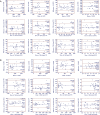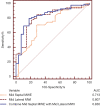The value of non-invasive myocardial work indices derived from left ventricular pressure-strain loops in predicting the response to cardiac resynchronization therapy
- PMID: 33816178
- PMCID: PMC7930681
- DOI: 10.21037/qims-20-754
The value of non-invasive myocardial work indices derived from left ventricular pressure-strain loops in predicting the response to cardiac resynchronization therapy
Abstract
Background: Non-invasive left ventricular (LV) pressure-strain loops (PSLs), which are generated by combining LV longitudinal strain with brachial artery blood pressure, provide a novel method of quantifying global and segmental myocardial work (MW) indices with potential advantages over conventional echocardiographic strain data, which suffers from being load-dependent. This method has been recently introduced in echocardiographic software, enhancing the efficiency of MW calculations. This study aimed to evaluate the role of non-invasive MW indices derived from LV PSLs in predicting cardiac resynchronization therapy (CRT) response.
Methods: A total of 106 heart failure (HF) patients scheduled for CRT were included in the MW analysis. Global and segmental (septal and lateral at the mid-ventricular level) MW indices were assessed before CRT and at a 6-month follow-up. Response to CRT was defined as ≥15% reduction in LV end-systolic volume and ≥1 NYHA functional class improvement at 6-month follow-up compared to baseline.
Results: CRT response was observed in 78 (74%) patients. At baseline, the global work index (GWI) and global constructive work (GCW) were significantly higher in CRT responders than in non-responders (both P<0.05). Furthermore, responders exhibited significantly higher mid lateral MW and mid lateral constructive work (CW) (both P<0.001), but significantly lower mid septal MWI and mid septal myocardial work efficiency (MWE) than non-responders (all P<0.01). Baseline mid septal MWE (OR 0.975, 95% CI: 0.959-0.990, P=0.002) and mid lateral MWI (OR 1.003, 95% CI: 1.002-1.004, P<0.001) were identified as independent predictors of CRT response in multivariate regression analysis. Mid septal MWE ≤42% combined with mid lateral MWI ≥740 mmHg% predicted CRT response, with an optimal sensitivity of 79% and specificity of 82% [area under the receiver operating characteristic curve (AUC) =0.830, P<0.001].
Conclusions: Assessment of MW indices before CRT could identify the marked imbalance in LV MW distribution and can be widely used as a reliable complementary tool for guiding patient selection for CRT in clinical practice.
Keywords: Cardiac resynchronization therapy (CRT); myocardial work; non-invasive; pressure-strain loop; segmental heterogeneity.
2021 Quantitative Imaging in Medicine and Surgery. All rights reserved.
Conflict of interest statement
Conflicts of Interest: All authors have completed the ICMJE uniform disclosure form (available at http://dx.doi.org/10.21037/qims-20-754). The authors have no conflicts of interest to declare.
Figures




Similar articles
-
Noninvasive Right Ventricular Myocardial Work by Pressure-Strain Loop: A New Perspective on Right Ventricular Function and Cardiac Resynchronization Therapy.Am J Cardiol. 2025 Oct 1;252:8-15. doi: 10.1016/j.amjcard.2025.05.024. Epub 2025 May 23. Am J Cardiol. 2025. PMID: 40414269
-
The value of left ventricular strain-volume loops in predicting response to cardiac resynchronization therapy.Cardiovasc Ultrasound. 2019 Feb 18;17(1):3. doi: 10.1186/s12947-019-0153-3. Cardiovasc Ultrasound. 2019. PMID: 30777069 Free PMC article.
-
Value of Myocardial Work Estimation in the Prediction of Response to Cardiac Resynchronization Therapy.J Am Soc Echocardiogr. 2018 Feb;31(2):220-230. doi: 10.1016/j.echo.2017.10.009. Epub 2017 Dec 13. J Am Soc Echocardiogr. 2018. PMID: 29246513
-
Assessment of mechanical dyssynchrony in cardiac resynchronization therapy.Dan Med J. 2014 Dec;61(12):B4981. Dan Med J. 2014. PMID: 25441737 Review.
-
Myocardial work: The analytical methodology and clinical utilities.Hellenic J Cardiol. 2022 Nov-Dec;68:46-59. doi: 10.1016/j.hjc.2022.07.007. Epub 2022 Aug 2. Hellenic J Cardiol. 2022. PMID: 35931412 Review.
Cited by
-
Association between resting myocardial work indices and stress myocardial perfusion in patients with angina and non-obstructive coronary artery disease.Quant Imaging Med Surg. 2023 Jul 1;13(7):4563-4577. doi: 10.21037/qims-22-321. Epub 2023 May 9. Quant Imaging Med Surg. 2023. PMID: 37456330 Free PMC article.
-
Quantitative assessment of left ventricular systolic function in patients with systemic lupus erythematosus: a non-invasive pressure-strain loop technique.Quant Imaging Med Surg. 2022 Jun;12(6):3170-3183. doi: 10.21037/qims-21-951. Quant Imaging Med Surg. 2022. PMID: 35655829 Free PMC article.
-
Cardiac reverse remodelling by imaging parameters with recent changes to guideline medical therapy in heart failure.ESC Heart Fail. 2023 Dec;10(6):3258-3275. doi: 10.1002/ehf2.14555. Epub 2023 Oct 23. ESC Heart Fail. 2023. PMID: 37871982 Free PMC article. Review.
-
Echocardiographic Myocardial Work: A Novel Method to Assess Left Ventricular Function in Patients with Coronary Artery Disease and Diabetes Mellitus.Medicina (Kaunas). 2024 Jan 24;60(2):199. doi: 10.3390/medicina60020199. Medicina (Kaunas). 2024. PMID: 38399487 Free PMC article. Review.
-
Application value of myocardial work technology by non-invasive echocardiography in evaluating left ventricular function in patients with chronic heart failure.Quant Imaging Med Surg. 2022 Jan;12(1):244-256. doi: 10.21037/qims-20-1038. Quant Imaging Med Surg. 2022. PMID: 34993075 Free PMC article.
References
-
- Bogale N, Priori S, Cleland JG, Brugada J, Linde C, Auricchio A, van Veldhuisen DJ, Limbourg T, Gitt A, Gras D, Stellbrink C, Gasparini M, Metra M, Derumeaux G, Gadler F, Buga L, Dickstein K, Scientific Committee NC, Investigators. The European CRT Survey: 1 year (9-15 months) follow-up results. Eur J Heart Fail 2012;14:61-73. 10.1093/eurjhf/hfr158 - DOI - PubMed
-
- Mor-Avi V, Lang RM, Badano LP, Belohlavek M, Cardim NM, Derumeaux G, Galderisi M, Marwick T, Nagueh SF, Sengupta PP, Sicari R, Smiseth OA, Smulevitz B, Takeuchi M, Thomas JD, Vannan M, Voigt JU, Zamorano JL. Current and evolving echocardiographic techniques for the quantitative evaluation of cardiac mechanics: ASE/EAE consensus statement on methodology and indications endorsed by the Japanese Society of Echocardiography. J Am Soc Echocardiogr 2011;24:277-313. 10.1016/j.echo.2011.01.015 - DOI - PubMed
-
- Kovács Z, Kormányos Á, Domsik P, Kalapos A, Lengyel C, Ambrus N, Ajtay Z, Piros G, Forster T, Nemes A. Left ventricular longitudinal strain is associated with mitral annular fractional area change in healthy subjects-Results from the three-dimensional speckle tracking echocardiographic MAGYAR-Healthy Study. Quant Imaging Med Surg 2019;9:304-11. 10.21037/qims.2019.02.06 - DOI - PMC - PubMed
-
- Park HE, Chang SA, Kim HK, Shin DH, Kim JH, Seo MK, Kim YJ, Cho GY, Sohn DW, Oh BH, Park YB. Impact of loading condition on the 2D speckle tracking-derived left ventricular dyssynchrony index in nonischemic dilated cardiomyopathy. Circ Cardiovasc Imaging 2010;3:272-81. 10.1161/CIRCIMAGING.109.890848 - DOI - PubMed
LinkOut - more resources
Full Text Sources
Other Literature Sources
Research Materials
Miscellaneous
